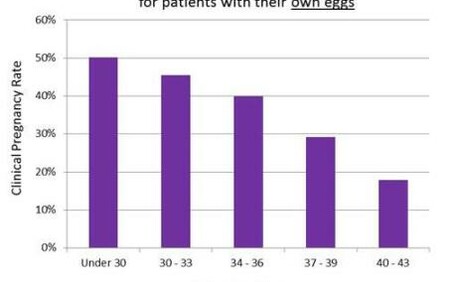
Understanding IVF success rates
If you’re starting IVF treatment or considering getting a second opinion, most patients will take a keen interest in a clinic’s IVF success rates. But what do these figures really mean and how do you compare them between clinics?
Defining IVF success
The first thing to be aware of is that unfortunately, there is no standard definition for reporting ‘success’ when it comes to IVF. One approach is to report clinical pregnancy rates (a pregnancy confirmed by a blood test and ultrasound scan, usually at around 6-8 weeks). However, it is important to remember that, as a result of miscarriages, not all clinical pregnancies will lead to live babies and clearly it’s the likelihood of welcoming a newborn baby into their family that is important. However, as the birth takes place in the year after the cycle, the clinical pregnancy rate provides the most up to date statistic.
What is an IVF 'cycle'?
When a woman begins IVF she normally goes through a series of injections leading to an egg collection followed by transfer of an embryo. Sometimes the cycle is cancelled before the eggs are collected, in which case, the normal charges of IVF do not apply. Sometimes after the eggs have been successfully collected there may be no transfer because no embryos have developed. In other cases, your doctor may advise you to postpone the transfer for instance, to carry out genetic testing on your embryos or to prevent complications if your hormone levels are very high. In other cases, many embryo transfers can result from one egg collection. Different clinics use different sub-groups to describe their results. At IVFAustralia, we describe our success rates per each embryo transfer as this is a constant event that is easy to compare. However you do need to be aware that, in some cases, you may not even have an embryo transfer. In other cases, one egg collection can result in several embryo transfers to give you, overall, a higher chance of success from the egg collection.
Who is in the ‘successful’ group?
When comparing fertility clinics, this is generally when you realise that you’re often not comparing apples with apples.
The most important factor affecting the chance of pregnancy success, whether spontaneous or via IVF, is the age of the woman. A woman’s fertility starts to decline slowly from her early 30’s onwards but declines rapidly after the age of 40. It’s not too surprising then that the average age of a woman undergoing a fresh IVF cycle is 36*. Look for a clinic that is transparent with its success rates and breaks them down into age bands. If you’re 40 you simply cannot compare your chance of success with a 30 year old.
Here’s an example of IVF Australia’s Success Rates, which shows the variation between age bands:

The other differences to look for are whether the success rates are based on all women starting an IVF cycle or only those that have an embryo to transfer, whether the rates include frozen embryo transfers, or whether their sample includes women using donor eggs.
Single embryo transfer
Australian fertility specialists have led the world in reducing the number of embryos transferred in an IVF treatment cycle – this reduces the chance of multiple pregnancies and therefore the risks to mothers and babies. At IVFAustralia 82% of all patients undergoing IVF treatment have a single embryo transfer, compared with 76.3% of the national cycles, and the chance of having a multiple birth through treatment at IVFAustralia is only 5.3% which is significantly lower than the national average of 6.5%.
It’s all in the numbers
As with all statistics, the higher the sample the more robust and reliable the figure. Larger clinic groups involving many fertility specialists caring for patients can offer you this, whereas individual clinics have a smaller patient population to draw from.
Also bear in mind that many clinics report cumulative rates, on average you will require more than one cycle before you are successful. Be aware of what you are trying to compare.
Is there an authoritative source of IVF success rates in Australia?
The University of NSW collates the success rates of all IVF cycles in Australia in an annual report. The most recent data available is for 2012 and includes pregnancy and live birth rates by a woman’s age, treatment type and the cause of infertility.
The latest average figures for all of Australia show that 22.8% of fresh IVF cycles result in a live birth and 22.2% of frozen/thawed embryo transfer cycles resulted in a live birth. Birth rates were much higher for younger women. Among those aged 30–34, the birth rate was 32.3% for fresh cycles and 26.4% for frozen/thaw cycles. For women aged 45 or over, it was less than 1.6% and around 5.4% respectively.* These figures are a good benchmark for you to compare any clinic success rates to. Be wary of any clinics that misrepresent this average in order to present a more dramatic looking result.
Can technology improve the likelihood of IVF success?
A number of technological interventions have been found to improve IVF success rates such as pre-implantation genetic diagnosis (PGD) to avoid chromosomal abnormalities, and, in some cases of male factor infertility,digital high magnification imaging of sperm. Other key advancements have been around fertilisation, embryo development and freezing methods. In addition, there are some emerging trial techniques (such as uterus scratching for repeat implantation failure) that are showing considerable promise.
Another example of this is the developments in cryopreservation techniques where the success rates after frozen embryo transfer are now equivalent to fresh cycle transfers, which ultimately reduces the number of cycles patients need to undertake to achieve a baby.
Make it about you
Whether you are embarking on fertility treatment for the first time, or seeking a second opinion after previous unsuccessful cycles, the best way to understand the likelihood of success for you and your partner is to have a consultation with a fertility specialist. Our role is to give you a thorough understanding of where you are now, and to work with you to develop the most suitable treatment plan moving forward.
Remember bar graphs are not always what’s important – achieving a pregnancy and delivering a baby is the definition of success. You need to find a fertility specialist you are comfortable with and who is caring for you, constantly refining your treatment to maximise the chance of success. This may also include referring to an expert review of experienced colleagues for challenging cases and bringing the latest technology to bear where necessary.
Read more: IVF Success Rates for Greater Sydney, IVF Success Rates for Melbourne, IVF Success Rates for Qld
